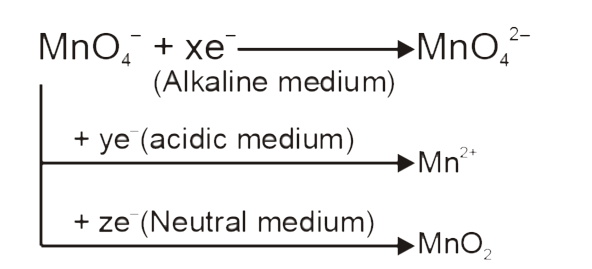The first ionization energy of magnesium is smaller as compare to that of elements X and Y, but higher than that of Z. The elements X,Y and Z respectively are:
chlorine, lithium and sodium
argon, lithium and sodium
neon, sodium and chlorine
argon, chlorine and sodium
To solve the problem, we need to analyze the ionization energies of magnesium and the elements X, Y, and Z.
1. Understanding Ionization Energy:
Ionization energy is the energy required to remove the outermost electron from an isolated gaseous atom. It generally increases across a period (from left to right) and decreases down a group (from top to bottom) in the periodic table.
2. Position of Magnesium:
Magnesium (Mg) is located in Group 2 (alkaline earth metals) and Period 3 of the periodic table. Its electron configuration is (Ne) 3s².
3. Comparing Ionization Energies:
- Elements X and Y have higher ionization energies than magnesium. This suggests that they are either in the same period but to the right of magnesium, or in a higher period.
- Element Z has a lower ionization energy than magnesium, which indicates that it is either in the same group but lower down or in a lower period.
4. Identifying Elements X and Y:
- Since X and Y must have higher ionization energies than magnesium, they could be elements like Aluminum (Al), Silicon (Si), Phosphorus (P), Sulfur (S), Chlorine (Cl), or Argon (Ar) which are to the right of magnesium in the periodic table.
- The most likely candidates for X and Y are Chlorine (Cl) and Argon (Ar), as they are known to have high ionization energies.
5. Identifying Element Z:
- Since Z has a lower ionization energy than magnesium, it could be an element in the same group as magnesium but lower down, such as Calcium (Ca) or Strontium (Sr), or an element in a lower period like Sodium (Na).
- The most likely candidate for Z is Sodium (Na), which is in the same period as magnesium but to the left.
6. Conclusion:
Thus, based on the analysis:
- Elements X and Y are Chlorine (Cl) and Argon (Ar) respectively, and Element Z is Sodium (Na).
Final Answer:
X = Chlorine (Cl), Y = Argon (Ar), Z = Sodium (Na).
Ionization energy is the energy required to remove the outermost electron from an isolated gaseous atom. It generally increases across a period (from left to right) and decreases down a group (from top to bottom) in the periodic table.
Magnesium (Mg) is located in Group 2 (alkaline earth metals) and Period 3 of the periodic table. Its electron configuration is (Ne) 3s².
- Elements X and Y have higher ionization energies than magnesium. This suggests that they are either in the same period but to the right of magnesium, or in a higher period.
- Element Z has a lower ionization energy than magnesium, which indicates that it is either in the same group but lower down or in a lower period.
- Since X and Y must have higher ionization energies than magnesium, they could be elements like Aluminum (Al), Silicon (Si), Phosphorus (P), Sulfur (S), Chlorine (Cl), or Argon (Ar) which are to the right of magnesium in the periodic table.
- The most likely candidates for X and Y are Chlorine (Cl) and Argon (Ar), as they are known to have high ionization energies.
- Since Z has a lower ionization energy than magnesium, it could be an element in the same group as magnesium but lower down, such as Calcium (Ca) or Strontium (Sr), or an element in a lower period like Sodium (Na).
- The most likely candidate for Z is Sodium (Na), which is in the same period as magnesium but to the left.
Thus, based on the analysis:
- Elements X and Y are Chlorine (Cl) and Argon (Ar) respectively, and Element Z is Sodium (Na).
X = Chlorine (Cl), Y = Argon (Ar), Z = Sodium (Na).
Topper's Solved these Questions
- JEE MAIN 2021BOOK - JEE MAINS PREVIOUS YEARCHAPTER - JEE MAIN 2021EXERCISE - Chemistry (Section B)
10 Videos
- JEE MAIN 2021BOOK - JEE MAINS PREVIOUS YEARCHAPTER - JEE MAIN 2021EXERCISE - CHEMISTRY SECTION B
30 Videos
- JEE MAINBOOK - JEE MAINS PREVIOUS YEARCHAPTER - JEE MAINEXERCISE - CHEMISTRY
150 Videos
- JEE MAIN 2022BOOK - JEE MAINS PREVIOUS YEARCHAPTER - JEE MAIN 2022EXERCISE - Question
561 Videos
Similar Questions
Knowledge Check

X,Y and Z are respectively:AHPO3,H4P2O7,P4O10BH4P2O7,HPO3,P4O10CH4P2O6,HPO3,P4O6DH4P2O6,H3PO2,P4O6
x,y and z are respectivelyA1,2,3B1,5,3C1,3,5D5,3,1
x,y and z are respectively-A1,2,3B1,5,3C1,3,5D5,3,1
The first ionization enthalpy of magnesium is higher than that of sodium. On the other hand, the second ionization enthalpy of sodium is very much higher than that of magnesium. Explain.
View SolutionThe first ionization enthalpy of magnesium is higher than that of sodium. On the other hand, the second ionization enthalpy of sodium is very much higher than that of magnesium. Explain.
View SolutionThe atomic masses of three elements X,Y and Z having similar chemical properties are 7,23 and 39 respectively
(a) Calculate the average atomic mass of elements X and Z
(b) How does the averge atomic mass of elements X and Z compare with the atomic mass of element Y
(c) Which law of classification of elements is illustrated by this example?
(d) What could the elements X,Y and Z be?
(e) Give another example of a set of elements which can be classified according to this law.
View SolutionA sum of ₹221 is divided among, X,Y and Z such taht X gets ₹52 more than X.Y gets ₹26 more than Z. The ratio of the shares of X,Y and Z respectively is :
View SolutionAtomic weight of an element X is 39, and that of element Z is 132, atomic weight of their intermediate element Y, as per Doeberiner triad, will be
View Solution
